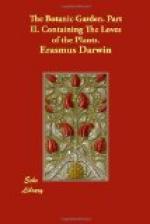Some bell-flowers close at night; others hang the mouths downwards; others nod and turn from the wind; stamens bound down to the pistil in Amaryllis formofissima; pistil is crooked in Hemerocallis flava, yellow day-lily Thorns and prickles designed for the defence of the plant; tall Hollies have no prickles above the reach of cattle
Bird-lime from the bark of Hollies like elastic gum
Adansonia the largest tree known, its dimensions
Bulbous roots contain the embryon flower, seen by dissecting a tulip-root
Flowers of Colchicum and Hamamelis appear in autumn, and ripen their seed in the spring following
Sunflower turns to the sun by nutation, not by gyration
Dispersion of seeds
Drosera catches flies
Of the nectary, its structure to preserve the honey from insects
Curious proboscis of the Sphinx Convolvoli
Final cause of the resemblance of some flowers to
insects, as the
Bee-orchis
In some plants of the class Tetradynamia, or Four Powers, the two shorter stamens, when at maturity, rise as high as the others
Ice in the caves on Teneriff, which were formerly hollowed by volcanic fires
Some parasites do not injure trees, as Tillandsia and Epidendrum
Mosses growing on trees injure them
Marriages of plants necessary to be celebrated in the air
Insects with legs on their backs
Scarcity of grain in wet seasons
Tartarian lamb; use of down on vegetables; air, glass, wax, and fat, are bad conductors of heat; snow does not moisten the living animals buried in it, illustrated by burning camphor in snow
Of the collapse of the sensitive plant
Birds of passage
The acquired habits of plants
Irritability of plants increased by previous exposure to cold
Lichen produces the first vegetation on rocks
Plants holding water
Madder colours the bones of young animals
Colours of animals serve to conceal them
Warm bathing retards old age
Male flowers of Vallisneria detach themselves from the plant, and float to the female ones
Air in the cells of plants, its various uses
How Mr. Day probably lost his life in his diving-ship
Air-bladders of fish
Star-gelly is voided by Herons
Intoxicating mushrooms
Mushrooms grow without light, and approach to animal nature
Seeds of Tillandsia fly on long threads, like spiders on the gossamer
Account of cotton mills
Invention of letters, figures, crotchets
Mrs. Delany’s and Mrs. North’s paper-gardens
The horologe of Flora
The white petals of Helleborus niger become first red, and then change into a green calyx
Berries of Menispernum intoxicate fish




